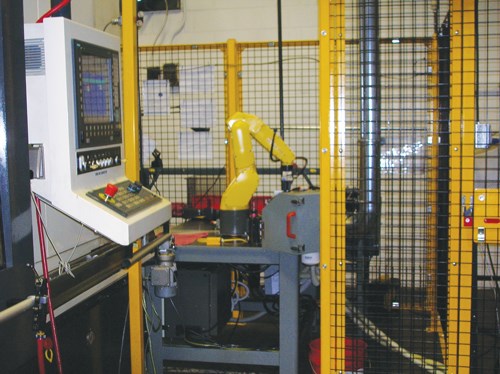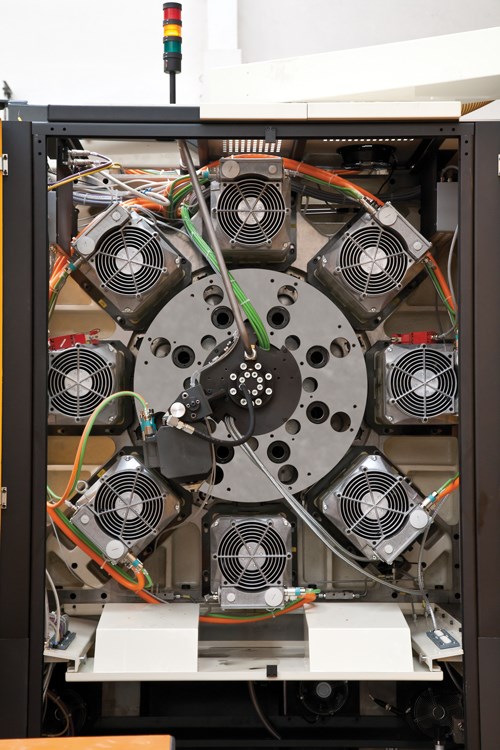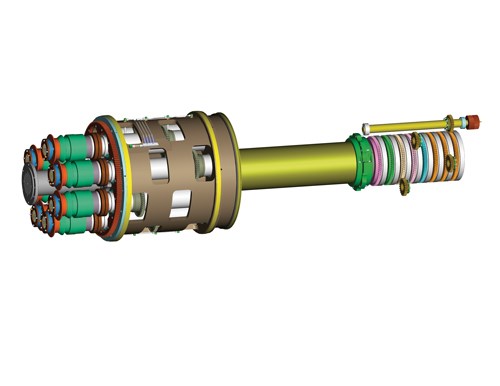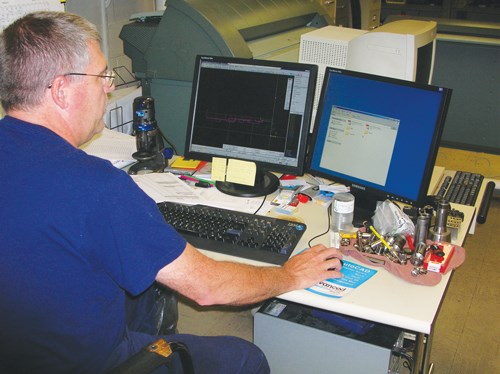Here, Multi-Spindles are Alive and Well
While the nature of multi-spindle work has changed over time, the demand for parts produced using this technology remains strong for this Midwest contract manufacturer, which successfully blends older cam and new CNC multi-spindle machine technologies.
Everybody has a comfort zone. However, strict adherence to the dreaded yet comfortable “this is how we’ve always done it” culture has led many companies out of business or at least to the brink.
That has not been the case for Mitchel & Scott Machine Company in Indianapolis, Ind. This third generation contract manufacturer has applied the appropriate level of technology to successfully serve its customers since the company’s founding in 1933.
Welcome! You’ve unlocked premium content.
According to Patrick Mitchel, grandson of the founder and director of quality and engineering, the family business has always searched out the right technology for the jobs at hand. That has led the company to invest in CNC multi-spindle technology to augment its Acme-based, multi-spindle department, but the philosophy carries over to other areas of the shop floor as well.
A Turning Shop
Mr. Mitchel describes his company as primarily a turning house. “When I started in 1985,” he says, “we had around 50 Acme Gridley multi-spindles and more than 60 Brown & Sharpe single-spindles. We were truly a turning focused shop.”
Manufacturing diesel engine components is its core business expertise. Injection components, valve train components, and a lot of shaft work make up much of the shop’s production mix. It’s a 160 person shop that handles volumes from 5 to 500,000 pieces.
Today, the shop runs 20 Acmes and 13 Brown & Sharpes. All but two of the “Brownies” are upgraded with Servo Cam conversion systems. The older machines have been slowly replaced with CNC technology that reflects changes in the nature of the business. Shorter runs with more frequent change-overs led Mitchel & Scott and many other traditional turning houses into CNC technology.
Last year, Mitchel & Scott Machine Co. completed a consolidation of its sister plant into a single campus that is now the main operation headquarters. “As the number of Acmes and B&S machines went down, we were able to consolidate two plants into one, which has proven to be a huge help in efficiency and logistics,” Mr. Mitchel says.
According to Mr. Mitchel, the shop’s biggest gains in production efficiency have been in process consolidation—going from a ten-step process to a five-step process. These gains have been made possible by using more capable machine tool technologies such as turn-mill machines and multitasking machines, such as Swiss, that allow consolidation of various operations in a single machine platform and a single handling of the part.
Instead of moving a job from one specialized machine to another, these newer machines allow for combining several operations performed on a single platform. “We’ve been able to incorporate side-hole drilling and light milling into one piece flow using work cells,” Mr. Mitchel says. “The shop is in a continuous process development mode incorporating lean principles into its production flow.”
The driver for these developments is to increase internal efficiencies. “The ability to get a price increase is virtually non-existent,” Mr. Mitchel says. “Therefore, we have to be more efficient internally to maintain a reasonable profit margin. Ultimately, these moves will be very good for us and for our customers.”
Process consolidation has lead to better labor efficiency for Mitchel & Scott. Mr. Mitchel cites a job that was blanked on a Brownie, went to a drill/tap center for two operations and then went to a hand deburring operation and is now made complete on one of the company’s CNS Swiss machines. Consolidation effectively helps deal with two issues: reducing labor costs and allowing the trained labor already employed to be used for higher value work.
Changing for the Good
Virtually every business in the precision machined parts industry has been impacted by outsourcing of work to foreign manufacturers. Mitchel & Scott has not been immune from this, either. However, that trend is reversing with positive benefits for U.S.-based manufacturing shops.
“Since about mid 2010 we’ve seen a change in the outsourcing justification from both existing and new customers,” Mr. Mitchel says. “A couple of our new customers, which are global companies that had outsourced to China, have told us if they have a component that is used in a subassembly in the U.S. and then ship the assembly to China, now they are looking for a domestic supplier. Costs of manufacturing here are now competitive enough to offset any advantages China once offered, plus doing business across the ocean is a logistical nightmare.”
So the realization for some of Mitchel & Scott’s customers is, why make something in China, ship it here for assembly and then ship it back to China for final assembly? It makes no sense. Now, these companies are searching out a good supplier here in the U.S. that they can visit and directly communicate with, which is helping fuel some of the reshoring work the company is seeing.
Multi-Spindles Doing Well
The company-wide efficiency drive carries over to the multi-spindle department as well. “The jobs we are currently running on our Acmes are doing well for us, and some of them are jobs we won back from outsourcing,” Mr. Mitchel says. “They are our high-volume work, and there are no parts we currently run that have not been thoroughly run more efficiently and consistently. These machines do for us what they were designed for—just sit there and run, making good parts every day.”
As for the seemingly universal problem of finding people who want to work on cam machines, Mr. Mitchel says they have been lucky finding young employees who seem interested in the challenges of the technology. “We tell the applicant if/when we have a job for them, and fortunately we’ve found several good people who have taken to the work and realize it’s not a “brain dead” job; you have to know what you are doing. It includes math, metallurgy, physics and mechanical skills that many applicants don’t associate with a factory job,” Mr. Mitchel says.
However, in today’s production environment, Acmes have limitations. Many new jobs that Mitchel & Scott are looking to bring in-house, especially automotive work, are beyond the capabilities of these machines. The pursuit of new multi-spindle work was a major contributor to Mitchel & Scott’s decision to invest in CNC multi-spindle machines.
The company chose ZPS America (Indianapolis, Ind.) for its newest CNC multi-spindles. Mitchel & Scott has two machines, a model 642, a six-spindle, 42-mm machine and a model 867, an eight-spindle, 67-mm machine.
In keeping with the company’s process consolidation drive, investing in new multi-spindle machines expands the machining capability of the multi-spindle by allowing it to perform operations in a single handling that would require secondary and sometimes tertiary operations on an Acme. This capability also translates into the ability to make more complex and close-tolerance work.
Why Use CNC Multi-Spindles?
New generation CNC multi-spindle machines, such as this available from ZPS America, are not really designed to replace cam machines directly. Rather, they represent a new machine tool class that allows shops willing to use them to rethink traditional processes and practices with an objective eye on how to lower production costs through improved throughput efficiencies.
Programmability is a major facilitator of these improved efficiencies. Cross slide and end slide strokes are programmable and can be changed by inputting offsets into the control. Changes are made electronically. Moreover, compound slides can be interpolated for single-point turning when form tools are not practical. “Because of the complexity of the workpieces, we program the multi-spindles and most the Swiss machines offline, and then download the programs as needed,” Mr. Mitchel says.
In cam machines, whether it is a five, six or eight spindle, the rotational speed settings for the main spindles is a compromise. There is no practical way to optimize each spindle speed for the operation being performed at that station.
Full CNC multi-spindles have independently programmable main spindles that enable ideal turning speeds that can be matched with tool slide feeds. This ability alone allows for improved surface finishes and tighter tolerancing.
While programmable main spindles are a hallmark of the CNC multi-spindle, builders approach the engineering challenge of independent speeds for each spindle while allowing the spindle drum to index from station to station from different angles. Most opt for direct drive motors mounted in the drum for each station.
Each of the motors must be supplied with power, so a cabling umbilical is needed for each. Power is maintained by either reversing the drum at 360 degrees or using a slip-ring that maintains power allowing the drum to index uni-directionally.
The ZPS machines use a third approach to this problem. Rather than use direct-drive, drum-mounted motors, the drive motors (six of eight) are attached on the periphery of the tailstock end of the machine. Since these motors are fixed and do not index with the drum, the umbilical problem is solved.
Power is transmitted to the spindle drum using concentric drive shafts that run through the tool block from the tailstock to the drum. Each of these shafts is connected directly from the drive motor to its individual spindle and is fully programmable. This drive system delivers mechanical advantage of 2 to 1 for torque. With the drive motors located away from the spindle drum, no inter-cooling of the drum is needed. The kinds of parts that process well on these machines generally require less turning and much more drilling, tapping, hobbing and milling operations than has been traditional on multi-spindles. Processing complex workpieces is how Mitchel & Scott is applying its CNC multi-spindles.
For shops with production volumes that are a bit too high for multitasking machines, CNC multi-spindles fill the bill nicely. The platform competes in both operational flexibility and quick change-over with the advantage of continuous throughput machining.
Dedicated and Available
Mitchel & Scott currently use each of its two ZPS CNC multi-spindles on a continuous run dedicated job. “We justified investment in these new CNC machines through a new customer, new work and production of a dedicated product, which created the need for added capacity,” Mr. Mitchel says.
Details of the job are confidential, but they are run on the CNCs because of complexity and the need for a single handling. The volumes for the job are sufficient to allow the machines to run 24/7 in the case of model 642 and 24/5 for the model 867.
Inspection of these parts is 100 percent and accomplished using a robot and laser gaging adjacent to the machine. “From machine to the box is how we compete on these jobs,” Mr. Mitchel says. “We looked at this job using conventional, single-spindle machine technology and figured it would take six to eight single-spindle machines and probably a vertical machining center to meet production. With that in mind, the CNC multi-spindle was a no-brainer.”
“We dedicate these machines to a single customer’s job,” Mr. Mitchel says. “But having CNC availability if it is needed is a good thing. It’s like an ace in the hole.”
Related Content
Index Corp. Turnkey Solutions Provide Flexible Manufacturing Performance
IMTS 2024: Index's C200 FANUC features powerful twin spindles that achieve rapid material removal.
Read MoreMethods Multitasking Machine Reduces Cycle Times
Methods Machine Tools Inc. introduces Nakamura-Tome’s WY-100V two-turret, twin-spindle precision CNC multitasking lathe to the U.S. market.
Read MoreSoftware Controls Chip Breaking in Thread Turning Operations
This cutting tool manufacturer has developed a software module for chip control of thread turning operations in virtually any CNC lathe, even for older machines, using specific tooling and software.
Read MoreStriving for Faster Changeovers for Multispindles
A multispindle platform designed to combine the high production speed of a cam-driven machine with the precision and repeatability of CNC also includes technology to speed set ups for new jobs.
Read MoreRead Next
Do You Have Single Points of Failure?
Plans need to be in place before a catastrophic event occurs.
Read More5 Aspects of PMTS I Appreciate
The three-day edition of the 2025 Precision Machining Technology Show kicks off at the start of April. I’ll be there, and here are some reasons why.
Read MoreA Tooling Workshop Worth a Visit
Marubeni Citizen-Cincom’s tooling and accessory workshop offers a chance to learn more about ancillary devices that can boost machining efficiency and capability.
Read More













.jpg;maxWidth=300;quality=90)





.jpg;maxWidth=300;quality=90)







